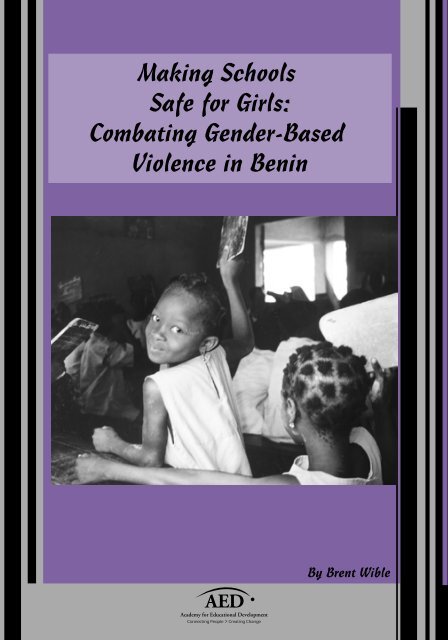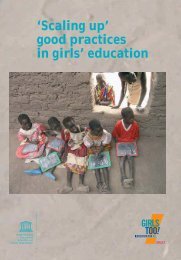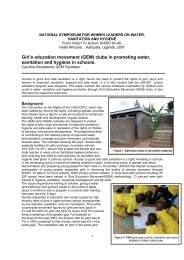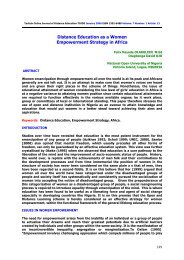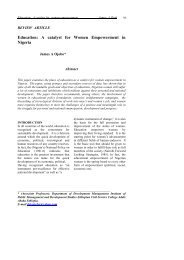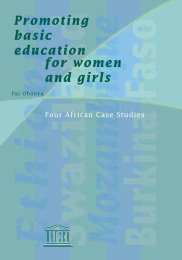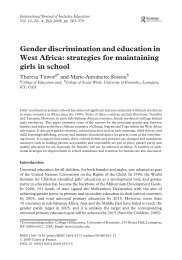Making Schools Safe for Girls - library.unesco-ii...
Making Schools Safe for Girls - library.unesco-ii...
Making Schools Safe for Girls - library.unesco-ii...
- No tags were found...
Create successful ePaper yourself
Turn your PDF publications into a flip-book with our unique Google optimized e-Paper software.
AcknowledgementsThanks to May Rihani <strong>for</strong> advice and supervision,Jim Silk <strong>for</strong> support and direction, and BobBernstein <strong>for</strong> making this fellowship possible. Iwould like to thank Joan Fiator <strong>for</strong> invaluableinput at all stages, as well as Léa Gaba Afouda,Agnes Ali, Francy Hays, Bienvenu Marcos, GiselleMitton, and Claude Diogo and family. I would alsolike to thank Joshua Muskin, Alexandra Orsini,and Setcheme Mongbo at World Learning whomade this research possible, and in particular theBeninese students, teachers, and parents who wereinterviewed. In addition, my gratitude goes toStephanie Psaki, who coordinated the productionof this publication.Brent WibleAfter graduating from Yale Law School, BrentWible worked at the Academy <strong>for</strong> EducationalDevelopment from 2003-2004 as a Robert L.Bernstein Fellow in International Human Rights.He worked under the supervision of May Rihani inthe Center <strong>for</strong> Gender Equity at AED.Founded in 1961, the Academy <strong>for</strong> EducationalDevelopment (www.aed.org) is an independent,nonprofit organization committed to solvingcritical social problems and building the capacityof individuals, communities, and institutions tobecome more self-sufficient. AED works in all themajor areas of human development, with a focuson improving education, health, and economicopportunities <strong>for</strong> the least advantaged in theUnited States and developing countries throughoutthe world.December, 2004
Gender-based Violence:A Problem in African <strong>Schools</strong>At the World Education Forum in 2000, UNESCO’s director <strong>for</strong> basic educationemphasized that girls often face an “unsafe environment” in schoolsaround the world, one that includes sexual harassment. Acknowledgingthis concern, the World Bank announced a new policy in 2002 to considersexual harassment in its education projects. While not exclusively or evenpredominantly an African issue, evidence suggests that sexual harassmentin schools is a growing problem across the continent. In response to thesefears, Education International, an organization dedicated to social justice ineducation, organized a regional <strong>for</strong>um on education in Benin in 2002 to addressabuse in African schools. This attention was provoked by a growingbody of quantitative and qualitative evidence documenting gender-basedviolence in schools across the continent.Gender-based violence is a global problem that causes more poor health anddeath than a host of other physical and psychological maladies combined,but it is only slowly being addressed by national public health policies andactions. Even more difficult to bring to the <strong>for</strong>efront is the issue of genderbasedviolence and sexual harassment in the one arena generally consideredsafe: the school. Both boys and girls are victims, but groping, bullying,verbal abuse, and rape are most often suffered by girls and young women.<strong>Girls</strong> are aggressively propositioned by male teachers and students in schooland by “sugar daddies” outside of school. Sexual violence and harassmentof girls is a direct cause of underachievement, dropout, damage to physicaland psychological health, early and unintended pregnancies, and STI transmission,including HIV/AIDS. In developing countries, about 40 percent ofgirls who start school will drop out be<strong>for</strong>e completing five years. Frequently,the reason is gender-based violence or the fear of sexual violence. Theconsequences are loss of educational opportunity, stagnation of girls’ schoolcompletion rates, and resulting loss of national productivity.Research on this issue is yielding startling results. Sexual abuse of schoolgirlsis institutionalized and pervasive. (Abuse of boys has received little researchattention.) <strong>Girls</strong> in every country studied face harassment, violence,rape, and the threat of rape from male students and from teachers. <strong>Girls</strong>leave school out of fear, or do not participate in class in order not to attract1
While student-student bullying and the harassment that many girls sufferon the way to and from school are troubling, widespread teacher-studentabuse has a systemic impact on the school environment. It sends girls apernicious message and provides a negative role model <strong>for</strong> boys. When ateacher abuses his position to extract sexual favors, he damages the socialfabric of the school, potentially devalorizing the school in the community’sestimation. This study thus focuses on teacher-student harassment, both becauseof the impact it has on schools and because Beninese students identifiedteachers as most often responsible <strong>for</strong> the harassment they experience inthe school environment.Defining ViolenceAs defined in the Declaration on the Elimination of Violence AgainstWomen, a U.N. General Assembly resolution passed in 1993, genderbasedviolence (GBV) is a term that is not limited to physical or sexualviolence, but also includes equally insidious <strong>for</strong>ms of violence againstgirls such as economically coerced sex, sexual harassment, demeaninglanguage that undermines self-esteem, and even assigning girls toper<strong>for</strong>m domestic tasks at school while others study. GBV is thus abroadly-defined term encompassing an array of behavior that causesphysical, sexual, or psychological harm to women or girls.The legal term “sexual harassment” is problematic when discussingteacher-student interactions. “Abuse” is perhaps a more apt description.Nonetheless, the term “sexual harassment” is widely used in Africa todescribe teacher-student relationships, and much of the GBV that occursin Beninese schools fits the classic definition of harassment. Sexualharassment is often classified into two basic types. The first is quidpro quo harassment, where something is offered in exchange <strong>for</strong> sex.Much of the GBV perpetrated by teachers against students in Benin istransactional. The second type involves the creation of an intimidating,hostile, or offensive environment. The prevalence of quid pro quoharassment in Beninese schools may well contribute to the second type,encouraging teachers and male students alike to act out against girls ininappropriate ways.3
Primary school girls in southern BeninJoan FiatorBenin, West AfricaSchoolgirls inAzové discuss whatthey would do tostop gender-basedviolence at schoolBrent Wible
While highlighting a phenomenon that undermines girls’ education, thisstudy does not seek to demonize schools or teachers. The majority of teachersin Benin and across the continent are serious, dedicated, and hard-working.Moreover, girls not in school remain more at risk of gender-based violence,pregnancy, and HIV/AIDS infection than those who are enrolled. Thisstudy seeks only to emphasize that schools are not always safe havens fromgender-based violence and that gender-based violence at school underminesgirls’ academic enrollment, achievement, and retention. Until projects andpolicies targeting girls’ education acknowledge the role gender-based violenceplays in schools, the promise of girls’ education may remain elusive.Ef<strong>for</strong>ts to Address Gender-BasedViolence in Beninese <strong>Schools</strong>Evidence suggests that Benin, like many of its neighbors, faces a phenomenonof gender-based violence in its schools. Since 1994, the World Bank,the Women in Development office of USAID-Benin, and the United NationsCommittee on the Rights of the Child have each recognized sexual harassmentin schools to have a limiting effect on girls’ enrollment and participationin Beninese schools. NGO ef<strong>for</strong>ts and policy developments in Beninhave taken preliminary steps to target the problem.Inappropriate sexual relationships between students and teachers were firstaddressed by a 1988 Ministry of Education policy. While the policy has beenen<strong>for</strong>ced only rarely, two of its provisions are striking. First, it set a tougherpenalty <strong>for</strong> a teacher who attempted abortion on a student than <strong>for</strong> a teacherwho had raped a student. Second, it is significant that the policy specificallyaddressed students who provoke teachers with “extravagant” hairstyles andperfumes. The policy thus seems to have been intended to preserve a particularconception of morality as much as to create a safe school environment,and it evinces a “blame the victim” understanding of sexual harassment.While the policy response to sexual harassment in schools has proved ineffective,the problem has grown in Benin. Women in Law and Development5
in Africa (WiLDAF) organized a nationwide series of workshops in 2002that provided insight into the phenomenon. During these sessions, studentsthroughout the country reported that harassment was common in theirschools. They noted the high incidence of sexual relations between teachersand students and, as in “cross-generational” or “sugar-daddy” relationshipsmore generally, identified a strong transactional element: the frequentexchange of money or grades <strong>for</strong> sex, as well as the threat of bad grades tocoerce girls into sexual relationships.Many participants in WiLDAF’s seminars raised the issue of girls who“harass” teachers, but few seemed to understand teachers’ responsibilityto resist their students’ advances. Generally speaking, the participants betrayedan understanding of women, students included, as seductresses—anattitude that likely contributes to the low reporting rate <strong>for</strong> sexual harassment.The dynamic is easy to imagine. If girls know they will be blamed<strong>for</strong> having invited the harassment, they will be unlikely to report what hashappened to them. Reflecting this problem, students typically felt that noappropriate solution to the problem existed and that a student simply couldnot report a teacher to school or legal authorities. These students’ pessimismis borne out in practice. The workshops showed that little punitive actionis taken against a responsible teacher, other than the occasional transferto a neighboring school where he is free to repeat his behavior.Shortly after WiLDAF’s workshops, the National Network <strong>for</strong> the Promotionof <strong>Girls</strong>’ Education released a documentary on gender-based violencein Beninese schools, focusing in large part on teacher misconduct. Finally,in 2003, a group of activists alarmed by the growing incidence of harassmentand other <strong>for</strong>ms of gender-based violence in Beninese schools used theNational Network’s documentary to successfully lobby <strong>for</strong> the drafting of anew policy on sexual misconduct in the school environment. The policy hasyet to be issued by the Ministry of Education.6
Research MethodsTwo large provincial towns and their surroundings in the Mono/ Couf<strong>for</strong>egion of southwestern Benin were identified <strong>for</strong> this case study, undertakenin partnership with the Center <strong>for</strong> Gender Equity at the Academy <strong>for</strong> EducationalDevelopment and World Learning’s Community Action <strong>for</strong> <strong>Girls</strong>’Education (CAGE) project. The research was carried out in January andFebruary of 2004, beginning with four half-day community workshops, eachinvolving 15-20 participants. Two of the workshops included upper primaryand lower secondary students, and two included parents with daughtersenrolled in school. The workshops used Participatory Learning and Action(PLA) techniques to:• Identify the problems at school that girls find most troubling.• Articulate female students’ perspectives on gender-based violence, discoveringwho perpetrates it, its frequency, and how it typically occurs.• Explore the factors that contribute to abusive behavior in the school environmentand consider possible strategies to address this problem.After the workshops, a total of 70 girls, 30 from primary school and 40 fromsecondary school, were interviewed individually. Ages ranged from 11 to 19due to high rates of over-age enrollment and frequent repetition of grades inBenin. Interview questions with girls covered: (a) their home background,including family members they live with; (b) their thoughts on the problemsthey have at school; (c) the types of GBV they had witnessed or experiencedat school; and (d) how GBV at school affects girls as well as what normally isand should be done about it.This case study, while not representative of the country as a whole, nonethelessprovides a window into what happens in Beninese schools, suggestingthat gender-based violence and teacher-student sex are more common thanmost schools care to admit.7
Fathers discuss sexual harassmentat school in Havou, outsideAplahoué, BeninBrent WibleSchoolgirls in Benin(above, left)© Jacob Silberberg/Panos Pictures
Research FindingsDuring the girls’ workshops,be<strong>for</strong>e sexualharassment had been introducedas the topic, thestudents were divided intotwo groups and asked toidentify problems theyface at school. “Teachersshould focus on their workas teachers rather thanpursuing their students <strong>for</strong>sex,” the first group said.“School authorities,” theycontinued, “should notProblems <strong>Girls</strong> Face at School• Teachers should focus on their workas teachers rather than pursuing theirstudents <strong>for</strong> sex.• School authorities should not grope or‘bother’ students in their offices.• Students must not seduce teachers or“negotiate” grades with sex.• Teachers must avoid pressuring theirstudents after their advances havebeen refused.grope or ‘bother’ students in their offices.” The second group agreed, addingthat girls should not seduce teachers or “negotiate” grades with sex. Byconfronting the subject without being prompted, the girls affirmed that coerciveor transactional sex is a common aspect of their educational experience.The interviews established more concretely that sexual harassment hasbecome deeply embedded in the Beninese schools included in this survey.Much of the in<strong>for</strong>mation culled from these interviews is conveyed as havingbeen “witnessed or experienced” because students were typically more com<strong>for</strong>tabletalking about other people than what may have happened to themselves.While the figures presented below are not statistically significant,they are nonetheless indicative of a profound problem.9
What kinds of gender-based violence are common in schools? Studentsidentified a number of behaviors that they had witnessed or experiencedat school. Pressure <strong>for</strong> dates, pressure <strong>for</strong> sex, inappropriate touching, andoffensive sexual jokes or gestures were each reported by a strong majorityas having been witnessed or experienced at secondary school. Almost twothirdsof secondary students reported witnessing or experiencing these behaviorsat least from time to time, with eight percent reporting that these behaviorsoccur daily. While primary school students reported less harassingor abusive behavior, gender-based violence is clearly a problem in primaryschool as well. Even if overstated, these figures are arresting, suggesting awidespread phenomenon of gender-based violence at school.10
Who is typically responsible <strong>for</strong> these behaviors? A strong majority of secondaryschool respondents indicated that teachers and administrators aremost often responsible <strong>for</strong> these behaviors, although fellow students alsoreportedly act in these ways. Primary school students, by contrast, identifiedother students, primarily older boys and high school students, as mostresponsible <strong>for</strong> this kind of behavior. Nonetheless, a third of primary schoolstudents reported that teachers harass students, and, in one school, mostrespondents had been propositioned or abused by a particularly notoriousteacher. As one primary student said, “A teacher in my school put pressureon many of the girls in my class to go to bed with him.”11
How common are teacher-student sexual relationships? Most studentsreported that teacher-student sexual relationships are either common orhappen sometimes in their schools. Over three-fourths reported knowinggirls who had been approached by teachers <strong>for</strong> sex, and another three-quartersbelieve that at least some teachers in their school are having sex withstudents, suggesting that much of the harassment in the Beninese schoolsincluded in this study is perpetrated openly, without regard <strong>for</strong> possible disciplinaryrepercussions.12
Why do girls become involved with teachers? <strong>Girls</strong> underscored the transactionaldimension that is characteristic of much teacher-student sex. Theyidentified the promise of good grades, the fear of bad grades, and the exchangeof money as the top three reasons <strong>for</strong> these relationships. Othermotivations, such as liking the teacher or feeling important, were reportedmuch less commonly. While several students spoke euphemistically ofacademic coercion, complaining that teachers often give girls “arbitrarygrades,” some identified the problem more directly. “I have a teacher whoharasses us girls and sometimes even threatens to give us bad grades if wedon’t accept his advances,” a secondary student explained. Another studentoffered an alternative explanation. “Teachers take advantage of girls’ financialsituation and court them. It is because parents support their girls verylittle at school,” she said.13
Where does school-related gender-based violence typically occur? More primaryand secondary school students identified the classroom as a site wheregender-based violence occurs more than any other place. While studentsreported that gender-based violence is perpetrated at the latrines and on thesports fields, many identified the school administrative offices as well. Asignificant number of both primary and secondary students also noted thatsuch misconduct happens at teachers’ homes. “These kinds of things happenat teachers’ houses. They ask a student to come help with the houseworkand then begin to court the student,” a secondary student explained.As several students noted, girls frequently help their teachers at home.“Teachers who are bachelors or living without their wives seek out studentsbecause they benefit from the girls’ help with the housework.” Other times,teachers offer study help, inviting students to visit them at home. “Sometimesteachers invite the class to his house to copy an old test <strong>for</strong> review, andhe courts certain girls,” a student said.14
Pregnancy is also a serious effect of sexual harassment at school. Of thosestudents who reported knowing at least one classmate who had becomepregnant, over three quarters (78 percent) believed a teacher to be the fatherin at least one case. These responses show that, based on the sample ofstudents in this study, Beninese students at least perceive gender-based violenceto be a serious problem in their schools.What are the spillover effects of school-based gender violence on girls generally?Many respondents complained that teacher-student sexual relationshipscreate the impression that all girls are the same, breeding resentmentin boys and exposing other girls to harassment at school. One student putit particularly well. “Because some girls go out with teachers to get goodgrades, this hurts the rest of us. The boys risk confounding all the othergirls in the class, especially those who do well in school, with those who are16
friends with teachers.” <strong>Girls</strong> also reported that boys often accuse them ofsleeping with teachers, suggesting that some boys balk at believing a girlcan do well at school, surpassing their own per<strong>for</strong>mance. “Boys sometimesaccuse girls of being ‘friends’ with the teacher when they see that a girl hastaken what they think is their place among the passing grades,” one studentsaid. Such accusations implicitly assert a lack of equality between boys andgirls, and girls’ academic successes are characterized as sexual rather thanintellectual.How are cases of gender-based violence at school addressed? If the widespreadharassment and gender violence in schools were not disturbingenough, the way cases are handled reveals that school authorities fail to takeit seriously. Few students believe that punitive measures are ever taken incases where a student or family complains of teacher misconduct. Whilealmost 80 percent of girls reported that teachers who pursue relationshipswith students should be fired, and that mediation by the school authoritiesshould also occur, most students reported that, especially in cases of studentpregnancy, the implicated student often drops out, the teacher apologizesto the family, or nothing happens at all. In some cases, the teacher is transferredto another school.Students themselves often say nothing to authorities, feeling that to report ateacher would be futile. “Who would I tell in the school administration if itis a teacher who has harassed me? They will protect their teachers and tell17
Looking Ahead —Strategies to Make <strong>Schools</strong> <strong>Safe</strong>r <strong>for</strong> <strong>Girls</strong>The parents and students who participated in the workshops discussedseveral possible actions to address gender-based violence in schools. Parentswanted more in<strong>for</strong>mation, particularly how the problem has beenaddressed elsewhere. While parents recognized the need <strong>for</strong> policies tocombat gender-based violence at school, they expressed little faith in schooland legal authorities, who they felt were either corrupt or unwilling to act.Significantly, several parents accepted some of the blame <strong>for</strong> the way girlsare treated at school. Acknowledging that the widespread practice of <strong>for</strong>cedmarriage and, as one parent put it, “a culture that does not emphasize consentingrelationships” likely created a permissive environment at school,they recognized that they would have to question their own cultural practicesif GBV at school were to be seriously addressed.Like their parents, girls recognized the need <strong>for</strong> a policy addressing gender-basedviolence. They wanted girls to feel com<strong>for</strong>table speaking outabout what happens to them at school rather than feeling ashamed. Manyexpressed interest in creating a student group that would work with schoolauthorities to ensure that girls no longer experience gender-based violenceat school.A few preliminary strategies, in addition to those just mentioned, merit consideration:• First, that so few students and parents are aware of any relevant laws orpolicies highlights the need <strong>for</strong> community education about children’s andyouth’s rights through community meetings and mobilization campaigns.• Second, NGOs should advocate <strong>for</strong> policy developments and disciplinarystructures covering the school environment to supplement existing laws inorder to ensure that schools become safer learning environments.• Third, an essential step to improve en<strong>for</strong>cement of existing laws is the establishmentof a confidential, effective complaint procedure. Without this,sexual harassment and gender-based violence in schools will remain a19
largely unreported offense. This could be as simple as posting a complaintbox on campus, outside the mayor’s office, or in the market, where complaintscould be made anonymously. Alternatively, a trusted PTA memberor student representative, perhaps a senior prefect, could volunteer to receivecomplaints from students, serving as a mediator between aggrievedstudents and the school administration.• Fourth, a number of important but uncoordinated ef<strong>for</strong>ts to address harassmentin Beninese schools, as well as creative strategies attempted in othercountries, point to the need <strong>for</strong> in<strong>for</strong>mation-sharing among groups workingon this issue. Sharing strategies and successes should lead to more effectiveadvocacy.• Fifth, establishing a means of openly discussing the issues, through communitymeetings, community theater, student clubs, popular radio or televisionprograms, or other media has been an important first step toward addressingthe problem in southern Africa, particularly in South Africa and Zimbabwe.Successful programs have allowed girls to speak freely, sharing theirexperiences with sexual harassment at school in order that students, parents,and teachers can be vigilant about preventing similar abuses in the future.• Finally, the most pressing task may involve changing attitudes. Despiteef<strong>for</strong>ts to condemn violence against women in Benin, sexual harassment remainsgenerally acceptable, even at school. Many students see harassmentas an inevitable part of school life and some teachers seem to believe theycan act with impunity. Only when such behaviors are generally understoodto be unacceptable, and particularly harmful when perpetrated by teachersagainst students, will schools become safe places that nurture girls, encouragingtheir participation and achievement.20
© Jacob Silberberg/Panos PicturesAcademy <strong>for</strong> Educational Development1825 Connecticut Avenue, NWWashington, DC 20009www.aed.org


